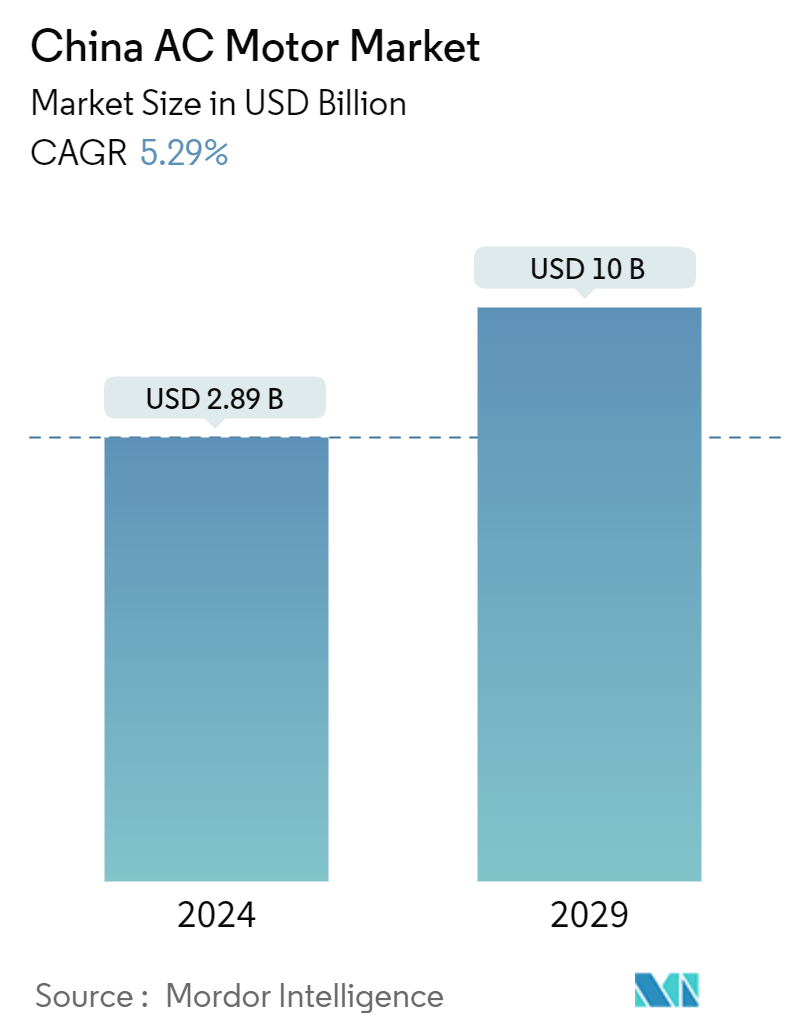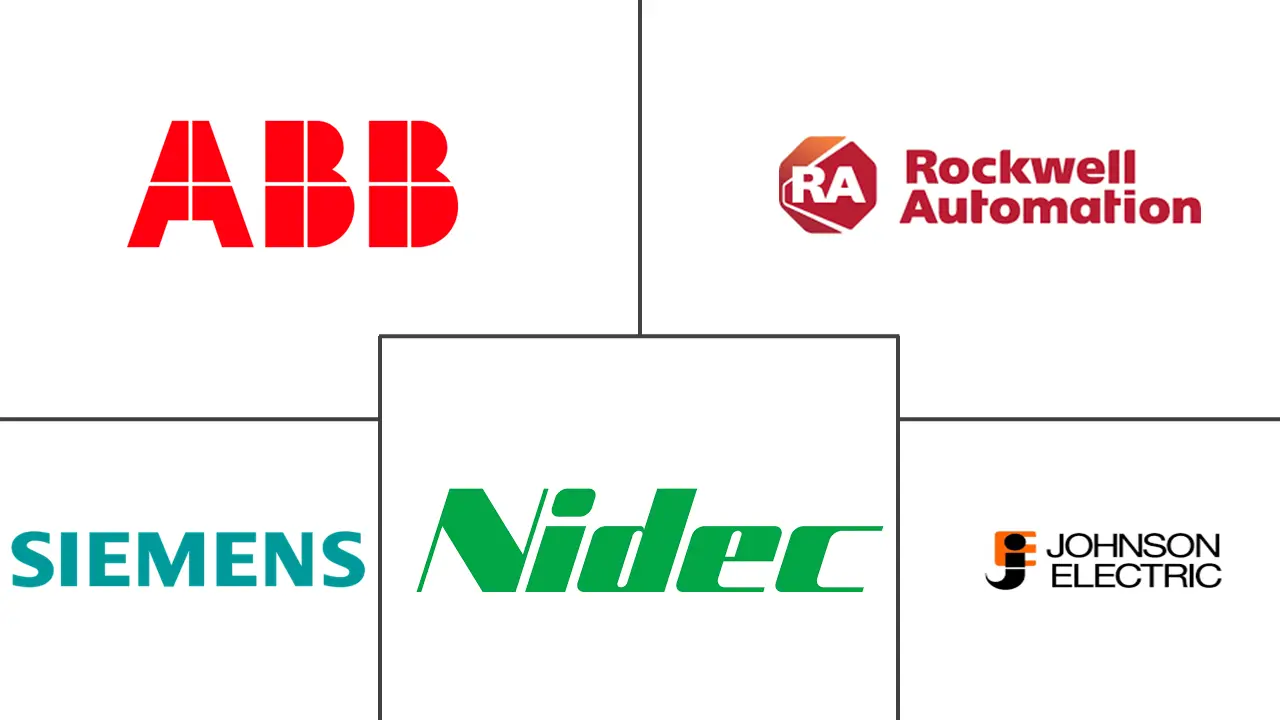Market Size of China AC Motor Industry

| Study Period | 2019 - 2029 |
| Base Year For Estimation | 2023 |
| Market Size (2024) | USD 2.89 Billion |
| Market Size (2029) | USD 10 Billion |
| CAGR (2024 - 2029) | 5.29 % |
| Market Concentration | Low |
Major Players
*Disclaimer: Major Players sorted in no particular order |
China AC Motor Market Analysis
The China AC Motor Market size is estimated at USD 2.89 billion in 2024, and is expected to reach USD 10 billion by 2029, growing at a CAGR of 5.29% during the forecast period (2024-2029).
- The Chinese manufacturing sector has a significant role in China's rapidly transforming economy, witnessing the rapid evolution of the Internet of Things as Industrial 4.0 gains momentum worldwide. This large-scale transformation has put the country in one of the leading positions in the AC motor market.
- Also, in October 2023, the Government of China announced that it would remove all restrictions on foreign investment access in the manufacturing sector. This move further demonstrates China's determination to continue promoting high-quality opening up with specific measures, which will also enhance the development of the domestic manufacturing sector, thus supporting market growth.
- China has been focusing on high-end manufacturing, power utilities, and oil and gas industries, boosting the usage of AC motors. For instance, the Chinese government's ambitious 'Made in China 2025' initiative, partially inspired by Germany for Industry 4.0, aims to boost the country's competitiveness in the manufacturing sector.
- Moreover, China has a large young population and a strong export sector, with a potential consumer base that far outstrips most other nations in the developed and developing world. Rising urbanization and a rapidly growing young population drive changes in consumer demand in the food and beverage industry. Such factors are likely to drive the growth of the studied market in China significantly.
- Fierce competition among various food companies also forces the food and beverage companies to introduce world-class manufacturing practices. This, in turn, also results in the increased adoption of AC motors.
- However, various barriers are hampering the adoption of AC motors. The significant costs for the motors are the energy, maintenance, and initial purchase costs.
China AC Motor Industry Segmentation
An electric motor is a machine that converts an alternating current to a mechanical motion. The applications of an AC motor include industrial bulk energy conversion from electrical to mechanical and household small power conversion.
The Chinese alternating current (AC) motor market is segmented by type (induction AC motors (single and poly phase) and synchronous AC motors (DC excited rotor, permanent magnet, hysteresis motor, reluctance motor)) and end-user industry (oil and gas, chemical and petrochemical, power generation, water and wastewater, metal and mining, food and beverages, and discrete industries). The report offers market size and forecasts for all the above segments in value (USD).
| By Type | |||||
| |||||
|
| By End-user Industry | |
| Oil and Gas | |
| Chemical and Petrochemical | |
| Power Generation | |
| Water and Wastewater | |
| Metal and Mining | |
| Food and Beverage | |
| Discrete Industries | |
| Other End-user Industries |
China AC Motor Market Size Summary
The China AC Motor Market is poised for significant growth, driven by the country's robust manufacturing sector and the rapid adoption of Industrial 4.0 technologies. The government's initiatives, such as the 'Made in China 2025' program, aim to enhance the competitiveness of the manufacturing industry, thereby boosting the demand for AC motors. The removal of foreign investment restrictions in the manufacturing sector further underscores China's commitment to fostering a high-quality open economy, which is expected to bolster the domestic manufacturing landscape. The increasing focus on high-end manufacturing, power utilities, and the oil and gas industries is propelling the use of AC motors, supported by a large young population and a strong export sector that drives consumer demand.
The market is characterized by intense competition among various players, including Siemens AG, Rockwell Automation Inc., Johnson Electric, Nidec Corporation, and ABB Limited, who are continually innovating to meet evolving consumer needs. The demand for AC motors is further fueled by the expansion of the automotive and electronics industries, with significant investments from companies like Volkswagen and Delta Electronics. Additionally, the Chinese government's increased defense spending and the growing electric vehicle market are contributing to the rising demand for AC motors. Despite challenges such as high energy and maintenance costs, the market is expected to thrive, supported by technological advancements and strategic investments in infrastructure and industrial projects.
China AC Motor Market Size - Table of Contents
-
1. MARKET INSIGHTS
-
1.1 Market Overview
-
1.2 Industry Attractiveness - Porter's Five Forces Analysis
-
1.2.1 Bargaining Power of Suppliers
-
1.2.2 Bargaining Power of Consumers
-
1.2.3 Threat of New Entrants
-
1.2.4 Threat of Substitutes
-
1.2.5 Intensity of Competitive Rivalry
-
-
1.3 Technology Snapshot
-
1.4 Impact of Macroeconomic Factors on the Market
-
-
2. MARKET SEGMENTATION
-
2.1 By Type
-
2.1.1 Induction AC Motors
-
2.1.1.1 Single Phase
-
2.1.1.2 Poly Phase
-
-
2.1.2 Synchronous AC Motors
-
2.1.2.1 DC Excited Rotor
-
2.1.2.2 Permanent Magnet
-
2.1.2.3 Hysteresis Motor
-
-
-
2.2 By End-user Industry
-
2.2.1 Oil and Gas
-
2.2.2 Chemical and Petrochemical
-
2.2.3 Power Generation
-
2.2.4 Water and Wastewater
-
2.2.5 Metal and Mining
-
2.2.6 Food and Beverage
-
2.2.7 Discrete Industries
-
2.2.8 Other End-user Industries
-
-
China AC Motor Market Size FAQs
How big is the China AC Motor Market?
The China AC Motor Market size is expected to reach USD 2.89 billion in 2024 and grow at a CAGR of 5.29% to reach USD 10 billion by 2029.
What is the current China AC Motor Market size?
In 2024, the China AC Motor Market size is expected to reach USD 2.89 billion.

